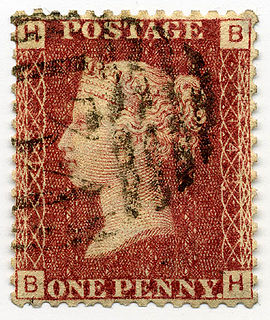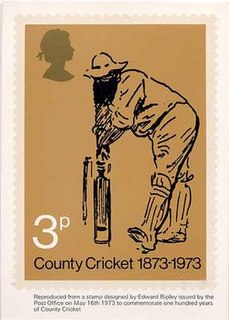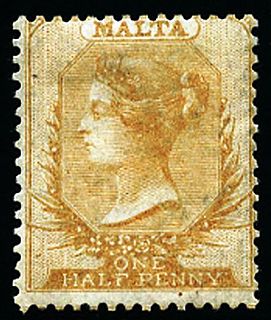The United Kingdom, known in philatelic circles as "Great Britain", released many commemorative stamps (postage stamps issued to honour or commemorate a place, event or person) in the 1970s.
Postage stamps were first issued in the United Kingdom on 6 May 1840, with the introduction of the world's first adhesive postage stamp, known as the Penny Black. Until 1924, all British stamps depicted only the portrait of the reigning monarch, with the exception of the "high value" stamps (also known as the "Sea Horses" design) issued in 1913, which were twice the size of normal stamps with added pictorial design.
In 1924, the first "commemorative" stamp was issued for the British Empire Exhibition. There were then occasional issues over the next thirty years, when the frequency of new issues became more regular. From the mid-1960s, in most years, six to nine sets of commemorative stamps have been issued every year. PHQ cards, postcard-sized reproductions of commemorative stamps, have also been issued to accompany every new set of stamps since the mid-1970s.
| Issue date | Issue details | Stamps in set | Designer(s) |
|---|---|---|---|
| 1970 | |||
| 11 February 1970 | British Rural Architecture | Four | David Gentleman [1] |
| 1 April 1970 | Anniversaries | Five | |
| 3 June 1970 | Literary anniversaries | Five | Rosalind Dease |
| 15 July 1970 | Ninth British Commonwealth Games | Three | |
| 18 September 1970 | "Philympia 70" Stamp Exhibition | Three | David Gentleman [1] |
| 25 November 1970 | Christmas | Three | |
| 1971 | |||
| 16 June 1971 | "Ulster 1971" Paintings (first decimal commemoratives) | Three | Stuart Rose [2] |
| 28 July 1971 | Literary Anniversaries | Three | |
| 25 August 1971 | British Anniversaries | Three | |
| 22 September 1971 | British Architecture | Four | |
| 13 October 1971 | Christmas | Three | |
| 1972 | |||
| 16 February 1972 | British Polar Explorers | Four | P.B. Powell |
| 26 April 1972 | General Anniversaries | Three | |
| 21 June 1972 | British Architecture, Village Churches | Five | |
| 13 September 1972 | Broadcasting Anniversaries | Four | David Gentleman [1] |
| 18 October 1972 | Christmas | Three | |
| 20 November 1972 | Royal Silver Wedding | Two | |
| 1973 | |||
| 3 January 1973 | Britain's entry into the European Communities | Three | |
| 28 February 1973 | Plant A Tree Year | One | |
| 18 April 1973 | British Explorers | Five | |
| 16 May 1973 | County Cricket 1873–1973 | Three | Edward M Ripley |
| 4 July 1973 | British Paintings | Four | |
| 15 August 1973 | 400th Anniversary of the Birth of Inigo Jones | Four | |
| 12 September 1973 | Commonwealth Parliamentary Conference | Two | |
| 14 November 1973 | Royal Wedding | Two | |
| 28 November 1973 | Christmas | Six | David Gentleman [1] |
| 1974 | |||
| 27 February 1974 | British Trees | One | David Gentleman [1] |
| 24 April 1974 | Bicentenary of Fire Prevention Act | Four | David Gentleman [1] |
| 12 June 1974 | Centenary of Universal Postal Union | Four | Rosalind Dease |
| 10 July 1974 | Medieval Warriors | Four | |
| 9 October 1974 | Birth Centenary of Sir Winston Churchill | Four | |
| 27 November 1974 | Christmas | Four | |
| 1975 | |||
| 22 January 1975 | Health & Handicap Funds | One | Philip Sharland |
| 19 February 1975 | Birth Bicentenary of J.M.W. Turner | Four | |
| 23 April 1975 | European Architectural Heritage Year | Five | |
| 11 June 1975 | Sailing | Four | |
| 13 August 1975 | 150th Anniversary of the first Steam Train | Four | |
| 3 September 1975 | 62nd Inter-Parliamentary Union Conference | One | |
| 22 October 1975 | Birth Bicentenary of Jane Austen | Four | |
| 26 November 1975 | Christmas | Four | |
| 1976 | |||
| 10 March 1976 | Telephone Centenary | Four (8+1⁄2p,10p,11p,13p) | |
| 28 April 1976 | Social Reformers | Four (8+1⁄2p,10p,11p,13p) | David Gentleman [1] |
| 2 June 1976 | Bicentennial of American Independence 1776–1976 | One (11p) | Philip Sharland |
| 30 June 1976 | Centenary of National Rose Society | Four (8+1⁄2p,10p,11p,13p) | |
| 4 August 1976 | British Cultural Traditions | Four (8+1⁄2p,10p,11p,13p) | |
| 29 September 1976 | 500th Anniversary of British Printing | Four (8+1⁄2p,10p,11p,13p) | |
| 24 November 1976 | Christmas | Four (6+1⁄2p, 8+1⁄2p, 11p,13p) | |
| 1977 | |||
| 12 January 1977 | Racket Sports | Four (8+1⁄2p,10p,11p,13p) | |
| 2 March 1977 | Royal Institute of Chemistry Centenary | Four (8+1⁄2p,10p,11p,13p) | |
| 11 May 1977 | Silver Jubilee (8+1⁄2p-10p-11p-13p values) | Four {full set = 5} | |
| 8 June 1977 | Commonwealth Heads of Government Meeting, London | One (13p) | Peter Murdoch |
| 15 June 1977 | Silver Jubilee (9p value) | One {full set = 5} | |
| 5 October 1977 | British Wildlife | Five (5 x 9p) | |
| 23 November 1977 | Christmas | Six (5 x 7p, 9p) | David Gentleman [1] |
| 1978 | |||
| 25 January 1978 | Energy Resources | Four (9p, 10p, 11p, 13p) | |
| 1 March 1978 | British Architecture | Four + Miniature sheet (9p, 10p, 11p, 13p) | Stamps: Ronald Maddox; Mini-sheet: Jeffery Matthews |
| 31 May 1978 | 25th Anniversary of the Coronation | Four | |
| 5 July 1978 | Horses | Four | Patrick Oxenham |
| 2 August 1978 | Centenaries of Cyclists' Touring Club and British Cycling Federation | Four | Fritz Wegner |
| 22 November 1978 | Christmas | Four | Faith Jacques |
| 1979 | |||
| 7 February 1979 | Dogs | Four | |
| 21 March 1979 | Spring Wild Flowers | Four | Peter Newcombe |
| 9 May 1979 | First direct elections to European Assembly | Four | |
| 6 June 1979 | Horse Racing paintings | Four | |
| 11 July 1979 | International Year of the Child | Four | |
| 22 August 1979 | Death Centenary of Sir Roland Hill | Four | |
| 26 September 1979 | 150th Anniversary of Metropolitan Police | Four | |
| 24 October 1979 | Death Centenary of Sir Roland Hill | Miniature sheet | |
| 21 November 1979 | Christmas | Five | Fritz Wegner |

Philately is the study of postage stamps and postal history. It also refers to the collection, appreciation and research activities on stamps and other philatelic products. Philately involves more than just stamp collecting or the study of postage; it is possible to be a philatelist without owning any stamps. For instance, the stamps being studied may be very rare or reside only in museums.
A first day of issue cover or first day cover (FDC) is a postage stamp on a cover, postal card or stamped envelope franked on the first day the issue is authorized for use within the country or territory of the stamp-issuing authority. Sometimes the issue is made from a temporary or permanent foreign or overseas office. Covers that are postmarked at sea or their next port of call will carry a Paquebot postmark. There will usually be a first day of issue postmark, frequently a pictorial cancellation, indicating the city and date where the item was first issued, and "first day of issue" is often used to refer to this postmark. Depending on the policy of the nation issuing the stamp, official first day postmarks may sometimes be applied to covers weeks or months after the date indicated.
This is a list of philatelic topics.

Postage stamps and postal history of Great Britain surveys postal history from the United Kingdom and the postage stamps issued by that country and its various historical territories until the present day.

This is an overview of the postage stamps and postal history of Australia.

A Christmas stamp is a postage stamp with a Christmas theme, intended for use on seasonal mail such as Christmas cards. Many countries of the world issue such stamps, which are regular postage stamps and are usually valid for postage year-round. They usually go on sale some time between early October and early December, and are printed in considerable quantities.

A revenue stamp, tax stamp, duty stamp or fiscal stamp is a (usually) adhesive label used to designate collected taxes or fees on documents, tobacco, alcoholic drinks, drugs and medicines, playing cards, hunting licenses, firearm registration, and many other things. Typically, businesses purchase the stamps from the government, and attach them to taxed items as part of putting the items on sale, or in the case of documents, as part of filling out the form.

The postage stamps of Ireland are issued by the postal operator of the independent Irish state. Ireland was part of the United Kingdom of Great Britain and Ireland when the world's first postage stamps were issued in 1840. These stamps, and all subsequent British issues, were used in Ireland until the new Irish Government assumed power in 1922. Beginning on 17 February 1922, existing British stamps were overprinted with Irish text to provide some definitives until separate Irish issues became available. Following the overprints, a regular series of definitive stamps was produced by the new Department of Posts and Telegraphs, using domestic designs. These definitives were issued on 6 December 1922; the first was a 2d stamp, depicting a map of Ireland. Since then new images, and additional values as needed, have produced nine definitive series of different designs.

A Presentation Pack typically contains a full set of a new stamp issue, produced for philatelists and stamp collectors. It normally comprises a folded card containing detailed notes about the stamps, a card with clear strips for holding the actual stamps, all held within a clear sleeve. The packs are usually sold at a price a little above the stamps' face value.

PHQ cards are postcards issued by the British Post Office depicting the designs of their commemorative stamps. They are generally available to buy in main post offices about two weeks prior to the release of each new set of stamps.
The United Kingdom, known in philatelic circles as Great Britain, released many commemorative stamps in the 1980s.
Commemorative stamps, postage stamps issued to honour or commemorate a place, event or person, have been released by Great Britain since 1924. Several sets were released during the decade of the 1990s.
A list of Great Britain commemorative stamps 2000–2009:

The postal history of Malta began in the early modern period, when pre-adhesive mail was delivered to foreign destinations by privately owned ships for a fee. The earliest known letter from Malta, sent during the rule of the Order of St John, is dated 1532. The first formal postal service on the islands was established by the Order in 1708, with the post office being located at the Casa del Commun Tesoro in Valletta. The first postal markings on mail appeared later on in the 18th century.

The postage stamps and postal history of Papua New Guinea originated in the two colonial administrations on the eastern part of the island of New Guinea and continued until their eventual merger, followed by independence in 1975.

The first postage stamps of Bhutan were issued in 1962, the same year that the first motorable road was opened. Before that there was a mail delivery system in place for official mail using mail runners, and between 1955 and 1962 revenue stamps were accepted as payment for internal mail. With the opening up of Bhutan in the early 1960s, a formal postal system was introduced. The American entrepreneur Burt Todd assisted in establishing a postage stamp program in the country and Bhutan became known for the unusual designs and materials of its stamps which were chosen by Todd specifically to attract attention. With the assistance of the Indian postal advisor Dr. K. Ramamurti, who was in Bhutan from 1964 to 1968, a proper postal organization and infrastructure was set up under the leadership of a young Bhutanese officer Mr. Lam Penjor, who became the Director of the Department of Posts and Telegraphs.

The Postal Union Congress (PUC) £1 stamp is one of a series of postage stamps of Great Britain issued in 1929. It is one of the classics of British philately and has been described as one of the most beautiful British stamps ever issued. The stamp was only the second British commemorative stamp to be issued. The first were the British Empire Exhibition postage stamps of 1924–25.
This is a list of Great Britain commemorative stamps 2010–2019
This is a list of Great Britain commemorative stamps 2020–2029